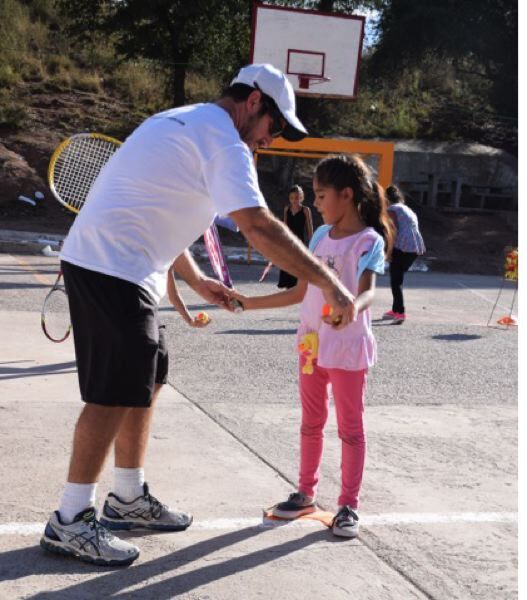World of possibilities unfolds for Cardinals alum Cutler
Published 12:00 am Tuesday, August 23, 2016

- All year, former Lincoln High tennis player Charlie Cutler has been visiting Arizona and Mexico, working up a curriculum of tennis and classroom work that can be shared across the border.
When inspiration meets need meets expertise, there’s no telling what great things might happen.
Trending
That’s where Charlie Cutler comes in.
Local tennis enthusiasts might recognize the name. Cutler, 29, who grew up in Portland and attended Ainsworth Elementary and Lincoln High, was a ranked player in the Pacific Northwest Tennis Association through his teens and played on a Cardinals team that won the Oregon School Activities Association Class 6A championship.
Now Cutler is creating magic on a larger scale as program director for the Border Youth Tennis Exchange, which will begin operation in October in Nogales, Arizona, and Nogales, Sonora, Mexico.
Trending
Cutler has raised more than $100,000 to seed the program patterned after the National Junior Tennis League model employed by Danice Brown at Portland’s St. Johns Racquet Center.
“My vision is to provide tennis programming and use it as a hook to get kids (from both border cities) involved in alternative after-school educational mentorship,” says Cutler during a recent stop-over in Portland to visit family and play in a pair of tennis tournaments in the city.
Cutler will run the program with his wife, Stefanie Tannenhaus. They married on Aug. 5 and have been living in San Francisco, but in the fall, they’ll head for Nogales, Arizona, to live and operate the start-up.
“I want it to become a long-term thing,” Cutler says. “I’m OK with living there for a while. Stefanie’s in.”
Cutler will be paid for his work. But as a graduate of Washington University in St. Louis, with a master’s degree in international human relations with an eye toward a potential career in law, this pursuit isn’t about the money.
What then?
First is tennis. Cutler loves the game enough to have played at Washington, where he served as captain his final two seasons and helped the Bears claim an NCAA Division III crown in 2008.
After college, Cutler played two years professionally on the Futures and Challengers circuits, mostly in Mexico, Guatemala and Venezuela. Cutler had been in the Spanish immersion program at Ainsworth and retained some of the language.
“I was the only one in our (tennis) group who could speak Spanish when we were in those countries,” Cutler says. “It reminded me that I had that inside and made me a little more interested to get it back.”
After his pro career ended, Cutler moved to the Bay Area, became a teaching pro at a private club and got a job as assistant coach for the University of San Francisco men’s team.
“I was transitioning out of the tennis world, but realized my whole résumé was tennis,” Cutler says. “I hadn’t had much experience in other areas.”
Cutler volunteered for the Lawyers Committee for Civil Rights, assisting in asylum cases as a pro-bono interpreter.
“It was a chance for me to use my Spanish and do something new,” he says. “Those cases were so powerful. Going into two-hour interviews in that realm was intense. I was very self-conscious about my role, that (the refugee petitioner’s) voice was coming out of my mouth and becoming a legal document.”
That experience led Cutler to pursue narrative for his master’s thesis in refugee asylum processing. And, last summer, to take an internship in Nogales, Arizona, working for an organization called the Border Community Alliance while doing research with immigrant refugee populations.
“That’s how I got to know the border community and that region as a whole,” Cutler says.
Border Community Alliance had a partnership with the Mexican Community Foundation, which oversees a network of nonprofits in Nogales, Sonora. The Mexican city’s population is more than 200,000 while Nogales, Arizona, is much smaller at 20,000.
“There is not a very strong tennis community in Nogales, Arizona,” Cutler says. “And there is no tennis community in Nogales, Sonora.”
Cutler decided to volunteer his time teaching tennis to ages 6 to 19 in Sonora.
“There are no tennis courts,” he says. “We played on a cement soccer field and a cement basketball court. I brought in a pop-up net, balls and racquets and gave 12 lessons at each of the facilities. I expected like six or seven kids. I’d have 35 show up.
“It was total mayhem, but it was super fun. The lessons were so popular with the kids, I saw the potential for creating that type of a program.”
Cutler proposed to the Border Community Alliance and Mexican Community Foundation the idea of professionalizing the program and creating something more long-standing.
“Everyone got on board,” he says. “We created an advisory committee. I was able to get a couple of USTA grants, and donations from members of my private club in S.F. I was surprised at how much support I was able to get.”
Cutler had known Brown since his childhood days, when she served as general manager at West Hills Racquet Club.
“I feel like I raised him,” says Brown, who now serves as executive director for Portland Tennis and Education out of St. Johns. “I probably spent more time with him than his parents did. You know how those club kids are. He was there every day.”
Brown’s highly successful program at St. Johns follows the NJTL model established by Arthur Ashe in the 1970s, combining tennis with education. Cutler reconnected with her to learn more about the program.
“They have developed this network of 600 of these facilities all throughout the U.S.,” Cutler says. “Danice has been awesome at introducing me to the model and to the USTA Foundation, learning how to run this kind project. She has been really helpful in showing me this new world.”
Since January, Cutler has visited Arizona every six weeks, spending a week meeting with educators, superintendents and representatives of his three partners — the Boys & Girls Club in Nogales, Arizona, and the Mexican Community Foundation and Youth Community Center on the Sonoran side.
“The idea is provide a mirror curriculum on each side, which will consist of an hour of tennis followed by an hour in the classroom,” he says. “We’ll use it as a way to connect them across the border for shared programming, to introduce the kids to each other — a new model for cross-border cooperation.”
Cutler will work with 15 youths from each city to start, teaching tennis to the kids and creating a foundation with parents and family members. He will work two days a week on the Arizona side, two days a week on the Mexican side, and one day a week in an interactive program with computer labs connecting the kids from both cities.
“The goals are to provide a unique programming that isn’t offered in these communities, to bring attention to the border region to something positive, and to develop a curriculum for digital cross-border interaction that could be replicated anywhere in the world,” Cutler says. “Providing low-income, at-risk communities with tennis and educational mentorship is a good thing. It’s not political. It’s nonthreatening. I’ve been surprised at how much support I’ve had all across the board.
“I love tennis. It’s driven my life and given me the opportunities I’ve had. You want to give back. But I never really appreciated until last year what a specific expertise in tennis can do, and what incredible access it can give you to communities in creating new ideas and programming.”
Cutler grew interested in volunteerism while coaching at USF, which was involved in a program with San Quentin State Prison. Cutler visited one day, “and I was blown away by how much the prisoners appreciated us being there, playing tennis with them,” he says. “It was such an incredible experience to see that environment.”
Cutler took over organizing volunteer groups and taught lessons to the prisoners. He and Stefanie got involved with the Prison University Project, teaching college introductory prep writing to the prisoners.
“Volunteer work is the best way to get your feet under you,” Cutler says. “If you’re willing to do it for free, people are willing to let you do some awesome stuff.”
What Cutler has done in Nogales has drawn the admiration of the region’s administrators.
“Charlie is fantastic,” says Jerry Haas, executive director of the Border Community Alliance. “He builds rapport really well. He has great ideas, great energy. Kids love him. Adults respect him.
“The key is reaching at-risk kids in the region, and that’s been a perfect fit with Charlie. He loves being able to make a difference. He’s a jock, but he’s bright, and his values are clearly oriented toward helping others. Tennis has been the vehicle for him.”
“We’re really excited to be working with Charlie,” says Vicki Barden, executive director of the Nogales Boys & Girls Club. “We don’t have a strong tennis community. It’s great to be able to offer kids something they’d otherwise be without. Charlie is fantastic — very enthusiastic, a hard worker. It’s amazing how quickly he’s pulled this program together.”
Brown told Cutler he needed to set up Nogales as a national tennis and learning chapter with the USTA.
“He came to our conference in Las Vegas and gave a presentation,” Brown says. “I knew they would support his project.”
In Nogales, Brown says, “Charlie is doing what the United Nations can’t do. The kids he works with on the Mexican side are primarily out of an orphanage. He has the American kids on the other side. Eventually he’ll have them together. He’s such a bright young man. I think the world of him.”
Brown and Cutler have talked about making Portland and Nogales sister NJTL cities.
“We’d like to make it a pen-pal type of thing,” he says.
It’s opened up a world of possibilities in the professional life of Charle Cutler.
“I’m really intrigued by the NJTL model,” he says. “For the interests and skills I have, it can be a career for me. If this thing takes off, I see the potential in 10 years, why wouldn’t we have a chapter in every border city? It’s a way to connect communities at the grass roots level.
“If not, I could see coming back to Portland and helping Danice with her program. Or if I don’t end up sticking with this career, I might go to law school.”
keggers@portlandtribune.com
Twitter: @kerryeggers







